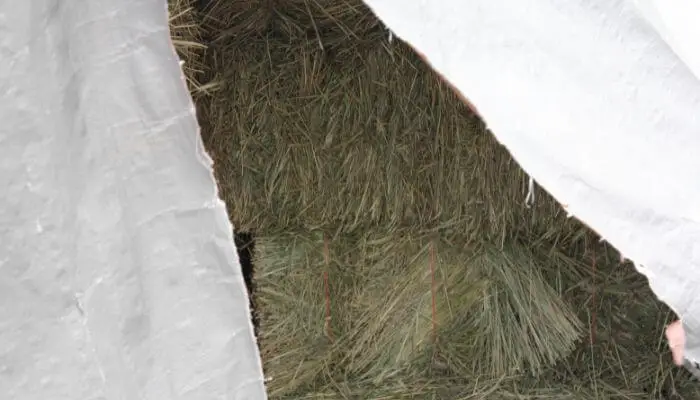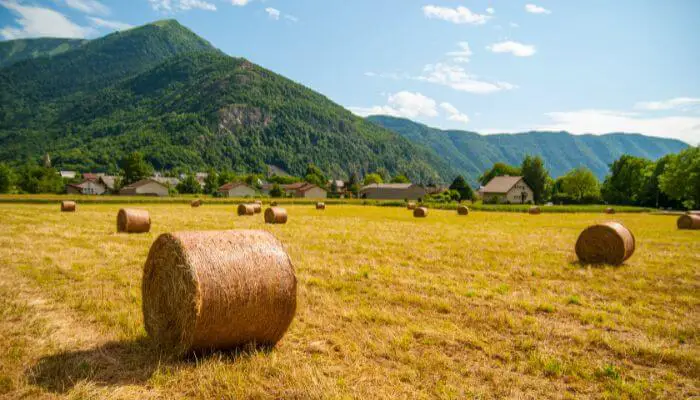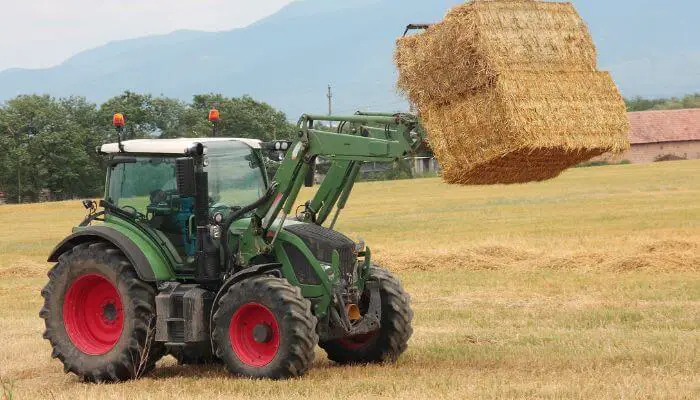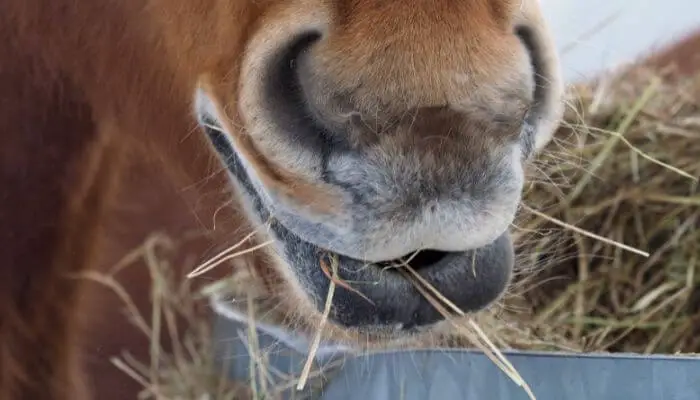A little spoil in a hay bale can quickly ruin your entire supply.
Farmers know firsthand how rotten hay can be difficult to fix, especially since it affects their animal feed supply and investment.
Below we have some helpful tips to show you how to keep hay dry outside all year round, no matter the weather.
1. Keep It Off The Ground
Keep hay off the ground as the soil contains moisture that will dampen your hay bales.
To keep your bales off the wet ground, use things like lumber, wooden pallets, or old truck tires to stack your hay bales on top, the same approach also works well for keeping firewood dry outdoors.
Additionally, cover the platform with a tarp before stacking your hay. This will do the trick in preventing further ground moisture from being absorbed by bales.
2. Keep It Covered
In addition to keeping your hay off the wet ground, it’s equally important to prevent it from getting moisture from rainwater or snow.

When storing hay outside, here are some covering options:
- Heavy-duty tarp and plastic wrap
- Steel barn or hay shed
- Net wrap
Heavy-Duty Tarp and Plastic Wrap
Heavy-duty tarp and plastic wraps, when properly wrapped over your bales, can protect them from rain. By doing so, you help extend the storage life of your hay.
When water collects on top of your covering, remove the tarp and allow bales to dry out any moisture.
Ensure that there aren’t any rips or holes in the plastic for the rain to seep in. Additionally, look out for water pooling at the base of your hay after heavy rains.
Furthermore, tarps and plastic wraps keep your hay from being blown by rough winds.
To fend off wind, tie your tarps down with strong cords. You can even weigh them down with heavy items, like tractor tires or rocks.
Steel Barn or Hay Shed
A dedicated steel barn for your bale is the most secure way of storing your hay. It safely keeps the tops of bales from pooling rain or melted snow.
Even a simple shed, with four pole posts and a roof overhead, is enough to protect your hay from the rain and harsh sunshine. On top of that, cover or tie up your bales so they don’t get blown off by the wind.
Having at least two feet of space between your highest haystack and the roof is also best.
Some farmers opt out of this solution due to its costliness or their lack of carpentry skills. However, if you have the budget or the skills to build a shed, this is worth investing in.
Putting up steel barns will help to immensely decrease molds and dry matter loss.
Net Wrap
For round bundled bales, net wrap is another effective way to deter rain, since it sheds the droplets off the hay. Its secure wrapping makes for easy carrying when transported to facilities.
Does Hay Need To Be Covered?
This question can be answered with a simple yes.
After the hay is appropriately cured to dry, it should be covered to preserve its quality. Too much sun exposure will dry out its nutrients, and absorbing rainwater will cause your hay to spoil.
A heavy-duty tarp with UV protection and a platform are recommended when you have no shelter.
3. Give Hay Good Air Circulation
It’s impossible to prevent your bales from completely absorbing moisture.
Still, you can help decrease the effects by properly ventilating the hay. The wetness seeping into your hay will dry faster with good air circulation.
This is a necessary process, especially during winters when moisture levels increase. To prepare a well-ventilated area for your hay, use wooden pallets, so moisture can drain from beneath.

Instead of covering the pallet with a tarp, lay it on the ground and leave the wood pallet as it is. Then, stack your hay accordingly so the air below can circulate well.
Some farmers stack their hays into rows from end to end, but you can individually stack them with three-foot gaps. If you prefer the former method, ensure three to four-foot spaces between rows, so there’s enough airflow for your bales to breathe.
When drying your hay, organize them from the sun’s north and south to get the most out of the heat.
For easy stacking, you can use plastic crates to store your hay. These items also aid airflow as plastic crates have holes for air to enter.
That said, you’ll still need a tarp cover to protect your plastic hay crates from undesirable weather conditions.
4. Get Rid Of Moldy Hay
All kinds of mold are detrimental to people and animal health. Unfortunately, molds will find their way into hay regardless of proper storage.
Usually, it’s the outer layer that spoils first. Use your gloved hand or a pitchfork to remove the spoilage.
If the mold runs a little deeper, sanitize your pitchfork in between to avoid contaminating the rest of your fresh hay. You can make the most of moldy hay by turning it into mulch fertilizer for your garden.
You may also feed your cows moderately moldy hay, as they have four stomachs to digest it better than most animals. However, moldy hay is toxic to horses, so it’s best to avoid feeding them with it.
Covered tarps can also trap moisture, which commonly happens in humid places. Consider organic hay desiccants or preservatives to retain the quality of your hay inside tarps.
5. Rotate Your Hay Bales
How you pack your bale affects the amount of moisture you let into your hay. Loosely-packed bales are usually prone to molds, like rectangular or square ones.

To determine the density of your packed bale, press your hand into it. You have a loose bale if it’s springy by over half an inch.
Tightly rounding or rotating your hay bales will have more density than square ones. Thus, securely wounding your bale into a cylindrical bundle is preferable.
6. Fix Any Leaks
If leaks are on your roof, prioritize fixing that to avoid water drips on your bale. Check for any tears or punctures on your tarp-covered bales as well.
7. Store Hay Away From Livestock
Storing your hay where livestock is kept can heavily damage your bales. How so?

When they eat from the stack or defecate on it, the bacteria will rapidly spoil your bale. If your livestock live outside of barns, their feeding bale should be kept dry with a roof above it.
How Long Does Hay Last Outside?
If you brought home hay for frequent feeding, you can store your hay outside, whether covered or uncovered, for quite some time.
Covered
Bales covered in tarp and elevated above platforms can last longer than uncovered ones. When the weather conditions aren’t severe, your hay can preserve its quality all year round and even more.
Uncovered
Hay stacked on platforms but uncovered can significantly lose quality and nutrients over time.
If there’s no precipitation, you can leave your hay uncovered for up to a good three months. If possible, it can even last up to six months max.
Enjoy Your Nice Dry Hay
Now, we’ve shown you foolproof ways on how to keep hay dry outside with proper storage.
Factors such as weather, natural elements, and ventilation should also be considered when storing your hay outside.
The best way to store your hay is by building a shelter over it. However, if roofed storage isn’t accessible, securely covering it with a tarp and keeping it off the ground with a platform is the following ideal method.
That said, all your harvesting efforts won’t go to waste. A healthy hay bale will keep your livestock healthy, too!

